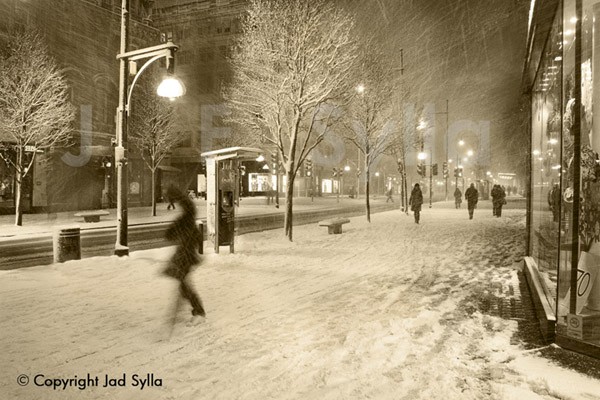Snow Acoustics

TTry and spend some time outside today. It's at least 4 times quieter than usual.
This is due to three factors:
1. We are all more likely to stay indoors today, less traffic, less people on the street.
2. The sound generated by surfaces that usually touch the ground will change in accordance to the amount of snow that has fallen. So the sound of tyres on snow is very different to the sound of tyres on tarmac.
3. The arrangement of snow itself absorbs sound. Fresh snow absorbs the most because it is full of air pockets. Snowflakes are all unique in shape, from flat plates to pointy stars - a big flake can be made of dozens of crystals. They form these air pockets as they fall lightly together, and this delicately balanced interlocking crystal maze that encloses huge amounts of air is responsible for robbing sound waves of their power. The pressure of the sound waves as they travel over the snow briefly pushes air into the spaces between the snowflakes, causing it to lose some of its energy.
How significant is the sound change? According to an article published in de Natuurkunde van het Vrije Veld by Dr. Marcel GJ Minnaert, a snow coverage of approximately 2.5 cm will transmit only 25% of a sound flowing over it. Friction, thermal effects and lots of this trapping also distorts the sound, drawing the wave out as bits are slowed and stretched by the pockets of air. So the sound you hear is a weakened muffled version of the original sound: A "bang" becomes a "whoomp" . The graph below shows a comparative study of what snow does to the sound of gunshot. Unfortunately, these acoustic qualities start to deteriorate almost immediately as this delicate porous structure is flattened by the wind, compacted by humans and vehicles, collapsed and blunted by rain, and melted by sunlight. The harder the snow is packed, the less air is contained within it and the more it starts behaving like bare ground or concrete, reflecting and transmitting sound. At which point you will hear noise rising back to nearly normal levels. Enjoy the quiet!
Sources: USACE Research & Development Nature, 143, 80, 1939 Kathy Wollard Dr. Marcel J. Minnaert, de Natuurkunde van het Vrije Veld